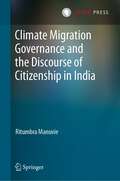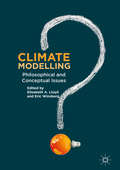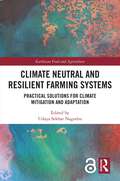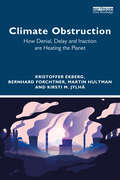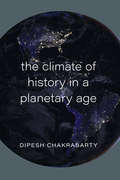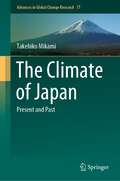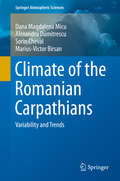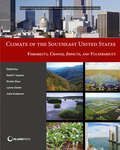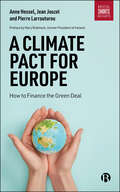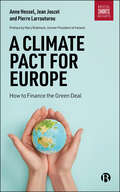- Table View
- List View
Climate map of Europe, north and central Africa (UEB Contracted)
by Rnib BookshareThis is a multi-page image of climate maps of Europe, north and central Africa, set on three pages. There are locator dots shown, which will be at the top left of each page when the images are the right way up.Key for climate map of Europe, north and central Africa: This page shows the key for the climate maps of Europe, north and central Africa. The rectangular areas of texture (or colour) representing the various climate regions found on the two map pages, are shown on the left of the page with descriptive text to the right. They are grouped so that areas of similar climate type appear near each other; so 'Tropical monsoon' follows 'Tropical equatorial'. Climate map - Europ: This is a map of Europe bounded by a dashed line image border. The map shows a part of Greenland in the top left hand corner. The right hand part of the page shows Western Europe and Russia. Blank areas within the image border show oceans. Climate map - north and central Africa : This is a map of north and central Africa bounded by a dashed line image border. The map shows a small portion of south America in the bottom left hand corner. In the middle of the page is central Africa. In the top right of the map is Israel and part of the Middle East. Blank areas within the image border show oceans.
Climate map of Europe, north and central Africa (UEB Uncontracted)
by Rnib BookshareThis is a multi-page image of climate maps of Europe, north and central Africa, set on three pages. There are locator dots shown, which will be at the top left of each page when the images are the right way up.Key for climate map of Europe, north and central Africa: This page shows the key for the climate maps of Europe, north and central Africa. The rectangular areas of texture (or colour) representing the various climate regions found on the two map pages, are shown on the left of the page with descriptive text to the right. They are grouped so that areas of similar climate type appear near each other; so 'Tropical monsoon' follows 'Tropical equatorial'. Climate map - Europ: This is a map of Europe bounded by a dashed line image border. The map shows a part of Greenland in the top left hand corner. The right hand part of the page shows Western Europe and Russia. Blank areas within the image border show oceans. Climate map - north and central Africa : This is a map of north and central Africa bounded by a dashed line image border. The map shows a small portion of south America in the bottom left hand corner. In the middle of the page is central Africa. In the top right of the map is Israel and part of the Middle East. Blank areas within the image border show oceans.
Climate Migration Governance and the Discourse of Citizenship in India
by Ritumbra ManuvieThis book offers an in-depth analysis of how governments in vulnerable regions respond to climate migrations. The author argues that, despite the newness of the discipline, responding to hydro-meteorological disasters at the sub-state level is fairly old and institutionalised. Using the example of India, and the State of Assam, the author demonstrates how existing rights-based frameworks are used as norms for governing climate migrations. However, these normative frameworks become futile when the sub-state simultaneously contests the status of climate migrants as legitimate citizens. Instead, the responsibility is replaced with pity-making and the state becomes an empathetic spectator - who understands the misfortune but refuses to be held accountable for either the development or protection of those worst affected by climate change. Those who migrate due to climate change often find themselves stripped of their lands (because of erosion) and their political belonging to the society. The volume will be useful for those studying climate migrations and disaster responses to better understand how communities which are most affected by climatic disasters may not even have a right to have rights against the State they found themselves in. Ritumbra Manuvie is a Senior Researcher and Lecturer of Law at the University of Groningen, The Netherlands. The author studied migration, citizenship, and belonging in Assam during her doctoral work at the University of Edinburgh. She is currently part of the ELSA - North Netherlands lab which aims to study Ethical, Legal, and Socio-political factors that influence the usage of AI in the health sector.
Climate Modelling: Philosophical And Conceptual Issues
by Elisabeth A. Lloyd Eric WinsbergThis edited collection of works by leading climate scientists and philosophers introduces readers to issues in the foundations, evaluation, confirmation, and application of climate models. It engages with important topics directly affecting public policy, including the role of doubt, the use of satellite data, and the robustness of models. Climate Modelling provides an early and significant contribution to the burgeoning Philosophy of Climate Science field that will help to shape our understanding of these topics in both philosophy and the wider scientific context. It offers insight into the reasons we should believe what climate models say about the world but addresses the issues that inform how reliable and well-confirmed these models are. This book will be of interest to students of climate science, philosophy of science, and of particular relevance to policy makers who depend on the models that forecast future states of the climate and ocean in order to make public policy decisions.
Climate Modelling: Philosophical and Conceptual Issues
by Elisabeth A. Lloyd Eric WinsbergThis edited collection of works by leading climate scientists and philosophers introduces readers to issues in the foundations, evaluation, confirmation, and application of climate models. It engages with important topics directly affecting public policy, including the role of doubt, the use of satellite data, and the robustness of models. Climate Modelling provides an early and significant contribution to the burgeoning Philosophy of Climate Science field that will help to shape our understanding of these topics in both philosophy and the wider scientific context. It offers insight into the reasons we should believe what climate models say about the world but addresses the issues that inform how reliable and well-confirmed these models are. This book will be of interest to students of climate science, philosophy of science, and of particular relevance to policy makers who depend on the models that forecast future states of the climate and ocean in order to make public policy decisions.
A Climate Modelling Primer
by Kendal McGuffie Ann Henderson-SellersAs a consequence of recent increased awareness of the social and political dimensions of climate, many non-specialists discover a need for information about the variety of available climate models. A Climate Modelling Primer, Third Edition explains the basis and mechanisms of all types of current physically-based climate models. A thoroughly revised and updated edition, this book assists the reader in understanding the complexities and applicabilities of today’s wide range of climate models. Topics covered include the latest techniques for modelling the coupled biosphere-ocean-atmosphere system, information on current practical aspects of climate modelling and ways to evaluate and exploit the results, discussion of Earth System Models of Intermediate Complexity (EMICs), and interactive exercises based on Energy Balance Model (EBM) and the Daisyworld model. Source codes and results from a range of model types allows readers to make their own climate simulations and to view the results of the latest high resolution models. The accompanying CD contains: A suite of resources for those wishing to learn more about climate modelling. A range of model visualisations. Data from climate models for use in the classroom. Windows and Macintosh programs for an Energy Balance Model. Selected figures from the book for inclusion in presentations and lectures. Suitable for 3rd/4th year undergraduates taking courses in climate modelling, economic forecasting, computer science, environmental science, geography and oceanography. Also of relevance to researchers and professionals working in related disciplines with climate models or who need accessible technical background to climate modelling predictions.
The Climate Modelling Primer
by Kendal McGuffie Ann Henderson-SellersAs a consequence of recent increased awareness of the social and political dimensions of climate, many non-specialists discover a need for information about the variety of available climate models. A Climate Modelling Primer, Fourth Edition is designed to explain the basis and mechanisms of all types of current physically-based climate models. A thoroughly revised and updated edition, this book will assist the reader in understanding the complexities and applicabilities of today’s wide range of climate models. Topics covered include the latest techniques for modelling the coupled biosphere-ocean-atmosphere system, information on current practical aspects of climate modelling and ways to evaluate and exploit the results, discussion of Earth System Models of Intermediate Complexity (EMICs), and interactive exercises based on Energy Balance Model (EBM) and the Daisyworld model. Source codes and results from a range of model types allows readers to make their own climate simulations and to view the results of the latest high resolution models. Now in full colour throughout and with the addition of cartoons to enhance student understanding the new edition of this successful textbook enables the student to tackle the difficult subject of climate modeling.
The Climate Modelling Primer
by Kendal McGuffie Ann Henderson-SellersAs a consequence of recent increased awareness of the social and political dimensions of climate, many non-specialists discover a need for information about the variety of available climate models. A Climate Modelling Primer, Fourth Edition is designed to explain the basis and mechanisms of all types of current physically-based climate models. A thoroughly revised and updated edition, this book will assist the reader in understanding the complexities and applicabilities of today’s wide range of climate models. Topics covered include the latest techniques for modelling the coupled biosphere-ocean-atmosphere system, information on current practical aspects of climate modelling and ways to evaluate and exploit the results, discussion of Earth System Models of Intermediate Complexity (EMICs), and interactive exercises based on Energy Balance Model (EBM) and the Daisyworld model. Source codes and results from a range of model types allows readers to make their own climate simulations and to view the results of the latest high resolution models. Now in full colour throughout and with the addition of cartoons to enhance student understanding the new edition of this successful textbook enables the student to tackle the difficult subject of climate modeling.
A Climate Modelling Primer
by Kendal McGuffie Ann Henderson-SellersAs a consequence of recent increased awareness of the social and political dimensions of climate, many non-specialists discover a need for information about the variety of available climate models. A Climate Modelling Primer, Third Edition explains the basis and mechanisms of all types of current physically-based climate models. A thoroughly revised and updated edition, this book assists the reader in understanding the complexities and applicabilities of today’s wide range of climate models. Topics covered include the latest techniques for modelling the coupled biosphere-ocean-atmosphere system, information on current practical aspects of climate modelling and ways to evaluate and exploit the results, discussion of Earth System Models of Intermediate Complexity (EMICs), and interactive exercises based on Energy Balance Model (EBM) and the Daisyworld model. Source codes and results from a range of model types allows readers to make their own climate simulations and to view the results of the latest high resolution models. The accompanying CD contains: A suite of resources for those wishing to learn more about climate modelling. A range of model visualisations. Data from climate models for use in the classroom. Windows and Macintosh programs for an Energy Balance Model. Selected figures from the book for inclusion in presentations and lectures. Suitable for 3rd/4th year undergraduates taking courses in climate modelling, economic forecasting, computer science, environmental science, geography and oceanography. Also of relevance to researchers and professionals working in related disciplines with climate models or who need accessible technical background to climate modelling predictions.
Climate Neutral and Resilient Farming Systems: Practical Solutions for Climate Mitigation and Adaptation (Earthscan Food and Agriculture)
by Udaya Sekhar NagothuThis book presents evidence-based research on climate-neutral and resilient farming systems and further to provide innovative and practical solutions for reducing greenhouse gas emissions and mitigating the impact of climate change. Intensive farming systems are a significant source of greenhouse gas emissions, thereby contributing to global warming and the acceleration of climate change. As paddy rice farming is one of the largest contributors, and most environmentally damaging farming systems, this will be a particular focus of the book. The mitigation of greenhouse gas emissions needs to be urgently addressed to achieve the 2 degrees Celsius target adopted by COP21 and the 2015 Paris Agreement, but this is not possible if local and national level innovations are not accompanied by international level cooperation, mutual learning and sharing of knowledge and technologies. This book, therefore, brings together international collaborative research on climate-neutral and resilient farming systems compiled by leading scientists and experts from Europe, Asia and Africa. The chapters present evidence-based research and innovative solutions that can be applied or upscaled in different farming systems and regions across the world. Chapters present models and technologies that can be used for practical implementation at the systemic level and advance state of the art knowledge on carbon neutral farming. Combining theory and practice, this interdisciplinary book provides guidance which can inform and increase cooperation between researchers from various countries on climate-neutral and resilient farming systems. Most importantly, the volume provides recommendations which can be put into practice by those working in the agricultural industry, especially in developing countries, where they are attempting to promote climate-neutral and resilient farming systems. The book will be of great interest to students and academics of sustainable agriculture, food security, climate mitigation and sustainable development, in addition to policymakers and practitioners working in these areas.
Climate Neutral and Resilient Farming Systems: Practical Solutions for Climate Mitigation and Adaptation (Earthscan Food and Agriculture)
by Udaya Sekhar NagothuThis book presents evidence-based research on climate-neutral and resilient farming systems and further to provide innovative and practical solutions for reducing greenhouse gas emissions and mitigating the impact of climate change. Intensive farming systems are a significant source of greenhouse gas emissions, thereby contributing to global warming and the acceleration of climate change. As paddy rice farming is one of the largest contributors, and most environmentally damaging farming systems, this will be a particular focus of the book. The mitigation of greenhouse gas emissions needs to be urgently addressed to achieve the 2 degrees Celsius target adopted by COP21 and the 2015 Paris Agreement, but this is not possible if local and national level innovations are not accompanied by international level cooperation, mutual learning and sharing of knowledge and technologies. This book, therefore, brings together international collaborative research on climate-neutral and resilient farming systems compiled by leading scientists and experts from Europe, Asia and Africa. The chapters present evidence-based research and innovative solutions that can be applied or upscaled in different farming systems and regions across the world. Chapters present models and technologies that can be used for practical implementation at the systemic level and advance state of the art knowledge on carbon neutral farming. Combining theory and practice, this interdisciplinary book provides guidance which can inform and increase cooperation between researchers from various countries on climate-neutral and resilient farming systems. Most importantly, the volume provides recommendations which can be put into practice by those working in the agricultural industry, especially in developing countries, where they are attempting to promote climate-neutral and resilient farming systems. The book will be of great interest to students and academics of sustainable agriculture, food security, climate mitigation and sustainable development, in addition to policymakers and practitioners working in these areas.
Climate Obstruction: How Denial, Delay and Inaction are Heating the Planet
by Kristoffer Ekberg Bernhard Forchtner Martin Hultman Kirsti M. JylhäIn Climate Obstruction: How Denial, Delay and Inaction are Heating the Planet, Kristoffer Ekberg, Bernhard Forchtner, Martin Hultman and Kirsti Jylhä bring together crucial insights from environmental history, sociology, media and communication studies and psychology to help us understand why we are failing to take necessary measures to avert the unfolding climate crisis. They do so by examining the variety of ways in which meaningful climate action has been obstructed. This ranges from denial of the scientific evidence for human-induced climate change and its policy consequences, to (seemingly sincere) acknowledgement of scientific evidence while nevertheless delaying meaningful climate action. The authors also consider all those actions by which often well-meaning individuals and collectives (unintendedly) hamper climate action. In doing so, this book maps out arguments and strategies that have been used to counter environmental protection and regulation since the 1960s by, first and foremost, corporations supported by conservative actors, but also far-right ones as well as ordinary citizens. This timely and accessible book provides tools and lessons to understand, identify and call out such arguments and strategies, and points to actions and systemic and cultural changes needed to avert or at least mitigate the climate crisis.
Climate Obstruction: How Denial, Delay and Inaction are Heating the Planet
by Kristoffer Ekberg Bernhard Forchtner Martin Hultman Kirsti M. JylhäIn Climate Obstruction: How Denial, Delay and Inaction are Heating the Planet, Kristoffer Ekberg, Bernhard Forchtner, Martin Hultman and Kirsti Jylhä bring together crucial insights from environmental history, sociology, media and communication studies and psychology to help us understand why we are failing to take necessary measures to avert the unfolding climate crisis. They do so by examining the variety of ways in which meaningful climate action has been obstructed. This ranges from denial of the scientific evidence for human-induced climate change and its policy consequences, to (seemingly sincere) acknowledgement of scientific evidence while nevertheless delaying meaningful climate action. The authors also consider all those actions by which often well-meaning individuals and collectives (unintendedly) hamper climate action. In doing so, this book maps out arguments and strategies that have been used to counter environmental protection and regulation since the 1960s by, first and foremost, corporations supported by conservative actors, but also far-right ones as well as ordinary citizens. This timely and accessible book provides tools and lessons to understand, identify and call out such arguments and strategies, and points to actions and systemic and cultural changes needed to avert or at least mitigate the climate crisis.
Climate-Ocean Interaction
by M. E. SchlesingerPreface This book is the culmination of a workshop jointly organized by NATO and CEC on Climate-Ocean Interaction which was held at Lady Margaret Hall, Oxford University during 26-30 September 1988. The objective of the ARW was to assess the current status of research on climate-ocean interaction, with a major focus on the development of coupled atmosphere-ocean-ice models and their application in the study of past, present and possible future climates. This book contains 16 chapters divided into four parts: Introduction; Observations of the Climate of the Ocean; Modelling the Atmospheric, Oceanic and Sea Ice Components of the Climatic System; and Simulating the Variability of Climate on Short, Medium and Long Time Scales. A fifth part contains the reports of the five Working Groups on: Climate Observations, Modelling, ENSO Modelling and Prediction, Climate-Ocean Interaction on TIme Scales of Decades to Centuries, and Impact of Paleoclimatic Proxy Data on Climate Modelling. Preface ix Acknowledgements I thank Howard Cattle and Neil Wells for their guidance and assistance as members of the Workshop Organizing Committee. I particularly thank Michael Davey for all his efforts as Local Organizer to make the ARW a success. I also thank the staff of Lady Margaret Hall, Oxford University, for their help with the arrangements for the ARW.
The Climate of China
by Manfred Domrös Gongbing PengSince the founding of the People's Republic of China in 1949there has been a rapid advance in climatology in China. The number of climatological stations has increased from less than 100 to more than of Chinese climatologists covers various 2,000, and the research work fields. The climate of China is no longer just a description of the average weather for an area or locality, but covers many fields such as the monsoon climate, the fluctuation of climate, the spatial and temporal variations of the climatic elements and physical and dynam ic climate. Four books on the climate of China, written in Chinese, have been published so far. There is, however, no excellent book written in English on the climate of China, although Volume 8 of the World Survey oj Climatology, dealing with the climates of northern and eastern Asia, edited by H. Arakawa in 1969, contains a chapter on the climate of China and Korea written by LE. M. Watts. The data sources for China are based mainly on observations from 1940-1952 and the climatological charts of China published by the Central Weather Bureau of China in 1953 and 1955. This monograph on The Climate ojChina by Prof. Dr. M. Dom ros and Prof. Peng Gongbing is the first comprehensive and advanced book in English on the climate of China.
The Climate of History in a Planetary Age
by Dipesh ChakrabartyFor the past decade, historian Dipesh Chakrabarty has been one of the most influential scholars addressing the meaning of climate change. Climate change, he argues, upends long-standing ideas of history, modernity, and globalization. The burden of The Climate of History in a Planetary Age is to grapple with what this means and to confront humanities scholars with ideas they have been reluctant to reconsider—from the changed nature of human agency to a new acceptance of universals. Chakrabarty argues that we must see ourselves from two perspectives at once: the planetary and the global. This distinction is central to Chakrabarty’s work—the globe is a human-centric construction, while a planetary perspective intentionally decenters the human. Featuring wide-ranging excursions into historical and philosophical literatures, The Climate of History in a Planetary Age boldly considers how to frame the human condition in troubled times. As we open ourselves to the implications of the Anthropocene, few writers are as likely as Chakrabarty to shape our understanding of the best way forward.
The Climate of History in a Planetary Age
by Dipesh ChakrabartyFor the past decade, historian Dipesh Chakrabarty has been one of the most influential scholars addressing the meaning of climate change. Climate change, he argues, upends long-standing ideas of history, modernity, and globalization. The burden of The Climate of History in a Planetary Age is to grapple with what this means and to confront humanities scholars with ideas they have been reluctant to reconsider—from the changed nature of human agency to a new acceptance of universals. Chakrabarty argues that we must see ourselves from two perspectives at once: the planetary and the global. This distinction is central to Chakrabarty’s work—the globe is a human-centric construction, while a planetary perspective intentionally decenters the human. Featuring wide-ranging excursions into historical and philosophical literatures, The Climate of History in a Planetary Age boldly considers how to frame the human condition in troubled times. As we open ourselves to the implications of the Anthropocene, few writers are as likely as Chakrabarty to shape our understanding of the best way forward.
The Climate of Israel: Observation, Research and Application
by Yair GoldreichThis book describes and analyses various aspects of Israeli climate. This work also elucidates how both man and nature adjust to various climates. The first part (Chapters 1-9) deals with the meteorological and climatological network stations, the history of climate research in Israel, analysis of the local climate by season, and a discussion of the climate variables their spatial and temporal distribution. The second part (Chapters 10-14) of this work is devoted to a survey of applied climatology. This part presents information on weather forecasting, rainfall enhancement, air quality monitoring, and various climatological aspects of planning. There is no sharp division between theoretical and applied climatology topics. Moreover, though various sections seem exclusively theoretical, they also include important applications for various real life situations (such as rainfall intensities (Section 5. 3), frost, frost damage (Section 6. 2. 4), degree-days (Section 6. 2. 5) and heat stress (Section 6. 2. 6). Professionals and university students of geography and earth science, meteorology and climatology, even high school students majoring in geography will be able to use this book as a basic reference work. Researchers in atmospheric science can also use this work as an important source of reference. Students of agriculture will also gain theoretical and practical insights. Even architects and engineers will gain another perspective in their fields.
The Climate of Japan: Present and Past (Advances in Global Change Research #77)
by Takehiko MikamiThis book clarifies the climatic variations in Japan from the historical period to the present based on documentary sources and meteorological data. Japanese society has suffered from various kinds of natural disasters since ancient times, such as floods and high tides caused by torrential rainfall and strong winds. They were described in large numbers of historical documents including official local weather diaries. However, all these documents were written in Japanese or Chinese languages, which prevents non-readers of those languages from accessing them. Also, Japan is a Far Eastern island country, and the unique features of Japanese climate and natural disasters would be unfamiliar and unimaginable to them without being able to read those documents. How is the climate of Japan, and how was the climate during the Little Ice Age in Japan as compared with conditions in Europe and America? When did meteorological observations start, and who (which country) introduced them to Japan? Why did so many natural disasters occur in Japan, and what caused them? This book answers these questions as specifically and objectively as possible using both figures and photographs, which are beneficial to students and the general public who are interested in historical and current climatic change in Japan, as well as professional climate scientists.
The Climate of the Arctic (Atmospheric and Oceanographic Sciences Library #52)
by Rajmund PrzybylakThis book is a new and revised second edition of the book ‘The Climate of the Arctic’, published in 2003. It presents a comprehensive analysis of the current state of knowledge related to the climate of the Arctic, using the latest meteorological data. All meteorological elements are described in detail and an up-to-date review of the available literature for each element is given. Climatic regions are distinguished and described. The monograph also provides an account of the present state of research on climate change and variability in the Arctic for three time scales: the Holocene, the last Millennium, and the instrumental period. The book concludes with a presentation of the scenarios of the Arctic climate in the 21st century.This monograph is intended for all those with a general interest in the fields of meteorology, climatology, and with a knowledge of the application of statistics in these areas.
The Climate of the Arctic (Atmospheric and Oceanographic Sciences Library #26)
by Rajmund Przybylakth Towards the end of the 19 century some researchers put forward the hypothesis that the Polar regions may play the key role in the shaping of the global climate. This supposition found its full confirmation in empirical and th model research conducted in the 20 century, particularly in recent decades. The intensification of the global warming after about 1975 brought into focus the physical causes of this phenomenon. The first climatic models created at that time, and the analyses of long observation series consistently showed that the Polar regions are the most sensitive to climatic changes. This aroused the interest of numerous researchers, who thought that the examination of the proc esses taking place in these regions might help to determine the mechanisms responsible for the "working" of the global climatic system. To date, a great number of publications on this issue have been published. However, as a re view of the literature shows, there is not a single monograph which comprises the basic information concerning the current state of the Arctic climate. The last study to discuss the climate of the Arctic in any depth was published in 1970 (Climates a/the Polar Regions, vol. 14, ed. S. Orvig) by the World Survey of Climatology, edited by H. E. Landsberg. This publication, however, does not provide the full climatic picture of many meteorological elements.
Climate of the Romanian Carpathians: Variability and Trends (Springer Atmospheric Sciences)
by Dana Magdalena Micu Alexandru Dumitrescu Sorin Cheval Marius-Victor BirsanThis book is a comprehensive climatic monograph, which addresses one of the most complex mountain environments in Europe, the Carpathians Chain, focusing on the branches that lie over Romania. The volume aggregates high quality input data, state-of-the-art techniques, regional analysis and overview perspectives, while addressing the spatial and temporal patterns of the main climatic elements. The study covers the period 1961-2010, for the present climate, while the perspective is extended up to 2050. The main climatic elements (e.g. air temperature, precipitation, wind) are analyzed, but some specific variables like snow depth and snow cover are also examined, both in terms of average behaviour and extreme characteristics. This is the first synthesis addressing the climate of this mountain region, and it provides useful information for scientists, mountain stakeholders, decision-makers and general public.
Climate of the Southeast United States: Variability, Change, Impacts, and Vulnerability (NCA Regional Input Reports)
by Keith T. Ingram, Kirstin Dow, Lynne Carter and Julie AndersonPrepared for the 2013 National Climate Assessment and a landmark study in terms of its breadth and depth of coverage, Climate of the Southeast United States is the result of a collaboration among three Regional Integrated Sciences and Assessments Centers: the Southeast Climate Consortium; the Carolinas Regional Sciences and Assessments and the Southern Climate Impacts Planning Program; with contributions from numerous local, state, federal and nongovernmental agencies to develop a comprehensive, state of the art look at the effects of climate change in the region.
A Climate Pact for Europe: How to Finance the Green Deal
by Anne Hessel Jean JouzelThe COVID-19 pandemic gives an opportunity to relaunch global economic systems with a better balance between the social and environmental dimensions. There is a need for a scientifically-based step towards a strong Green Deal: a Climate Pact for the EU. Based on a bestselling French book, this English translation provides a summary of the facts on the climate issue, the solutions available and their costs. It outlines the political advantages and challenges current policy, practice and thinking at a time when populist leaders are transforming politics worldwide. This timely book will contribute to a renewed political vision for the EU, the European Economic Area, the UK and Africa.
A Climate Pact for Europe: How to Finance the Green Deal
by Anne Hessel Jean JouzelThe COVID-19 pandemic gives an opportunity to relaunch global economic systems with a better balance between the social and environmental dimensions. There is a need for a scientifically-based step towards a strong Green Deal: a Climate Pact for the EU. Based on a bestselling French book, this English translation provides a summary of the facts on the climate issue, the solutions available and their costs. It outlines the political advantages and challenges current policy, practice and thinking at a time when populist leaders are transforming politics worldwide. This timely book will contribute to a renewed political vision for the EU, the European Economic Area, the UK and Africa.

